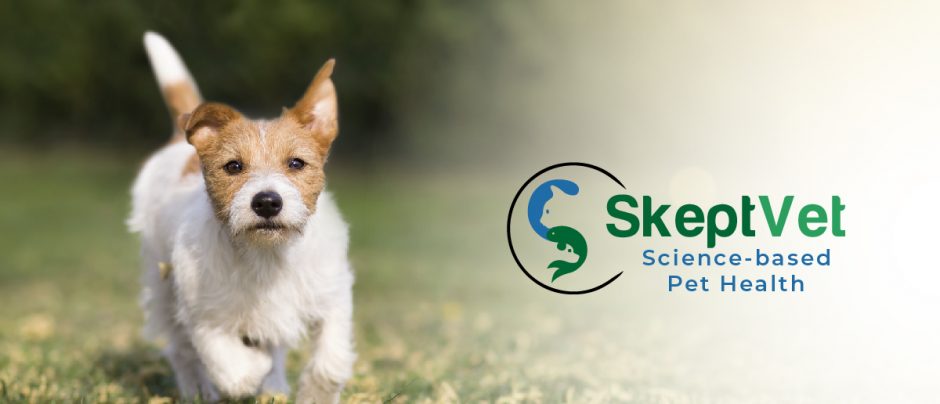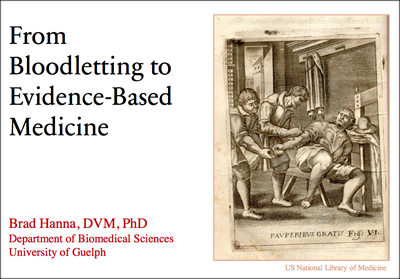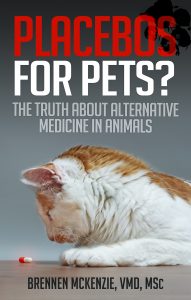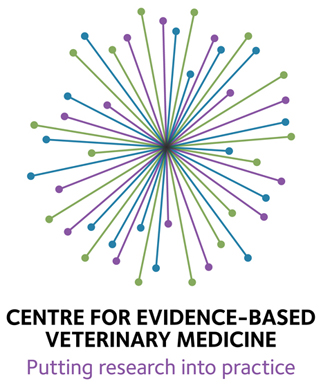Here is another excellent, informative post from contributing author and dog trainer Kyzyl.
Pressure Wraps for Anxiety and Fearful Behavior
Fear is a set of evolutionarily important behaviors for animals. Fear often keeps animals alive in a dangerous world by teaching them to avoid things that could bring about their untimely end. However, when fearfulness runs out of control or is coupled with common, innocuous events, it can become a serious behavior problem for pets and their owners. Whether it is associated with specific triggers, such as car rides, thunderstorms, and veterinary visits, or generalized, excessive anxiety and fearfulness can intensify to the point where normal functioning becomes impossible, and pets can act out in extreme ways including aggressively, urinating and defecating on themselves, or shutting down completely when forced into situations that trigger fear.
If your dog has moderate or severe problems with fear, there are a limited number of treatments to help alleviate anxiety including behavior modification and drug therapy. Behavior modification, when done effectively, is very successful at alleviating considerable amounts of stress due to specific stimuli. Behavior modification plans for fearful dogs often consist of two techniques: counter conditioning and systematic desensitization. These techniques change behavior by changing the underlying emotional state of the dog, therefore relieving the stress and anxiety of the fear-based behavior (8). In severe cases, vets might also prescribe a sedative to help with specific situations like grooming or veterinary visits or general anxiety or an anti-anxiety medication to reduce fear enough to improve the patient’s quality of life and allow behavior modification a chance to work.
However, behavior modification techniques are often very difficult for owners to execute correctly. Behavior modification tools require training skill and time, neither or which average owners can often provide. And many owners are also very reluctant to medicate their pets for behavior problems.
As a result, many owners and trainers have turned to alternative therapies that promise great results for treating phobic behavior, one of which is pressure wraps. Commercial pressure wraps (the Anxiety Wrap® and the ThundershirtTM) use elastic fabric and velcro to create a tight-fitting garment that is worn during anxiety-causing events. When fitted properly, the garment creates distributed pressure over the chest, sides, and back that supposedly has a calming effect.
How do they work? According to the ThundershirtTM website, several reasons were listed as evidence for why the product’s gentle pressure worked to calm anxious behavior (10). These include a reference to people with autism using pressure to relieve anxiety, swaddling as a method of calming upset babies, acupressure, and TTouch practitioners using pressure to address anxiety. These are not high-quality sources of evidence, but interesting ideas to consider none the less.
While there is little research on touch and pressure therapies in dogs, the effects of these therapies have been studied in humans and other mammals. Touch is critical for normal development of infant rats and humans and profoundly affects our social interactions (1,2,9). We know that touch, especially deep touch such as a hug, releases endorphins that promote relief from pain and a sense of well-being and self-reported improvement of symptoms of compulsive disorders and depression in humans(1,2).
Massage has long been used to successfully address issues with musculoskeletal pain, but when used to treat anxiety in people results have been both positive and negative leading to an inconclusive answer on whether or not it is useful treatment for anxiety (1,3,4,5).
Knowing that generally pressure and touch have effects on people, and by extension pets, makes evaluating claims of specific systems that employ it very difficult. Firstly, since general touching provides many of the benefits claimed through the system, it may be that the specific motions, actions, or places suggested by different systems of touching are not as important as the act of touching itself. Without controlling for these general effects, one can never be sure if positive results are due to the general effects or more specific effects of the system’s protocol.
Other modalities supporting pressure for anxiety relief, such as acupressure and Tellington TTouch®, have very little supporting evidence. Acupressure, a variation on acupuncture where acu-points are pressed to influence the flow of qi, has been addressed several times on this blog (12). In the great majority of cases, it has no specific effect beyond placebo or sham treatments. Tellington TTouch® combines specific touches with exercises in order to, as its website claims, “activate the function of cells and awaken cellular intelligence” (16). (Though anxiety and fear may be a big problem for a dog, I doubt it has much to do with how ‘intelligent’ its cells are.) Despite the complicated protocols and mystical thinking called for by both, no evidence these modalities work beyond the general effects of touching.
The effects of touch seem to be best studied in systems with human contact, touch by a human, and there is no reason to think that touching by inanimate objects would have the same effects. A supporting example referenced on the ThundershirtTM website illustrates this: swaddling babies. Is it the tight wrapping that calms the child, or the warm touch of its mother? These claims should be evaluated separately to determine the effectiveness of a pressure wrap.
What is the specific evidence for pressure wraps? People with autism report anecdotally feeling at ease when experiencing pressure from inanimate objects. Dr. Temple Grandin, who is referenced on the ThundershirtTM website (10), developed a hugging machine to help her through anxiety related to autism.. This machine allowed the user to control the duration and intensity of pressure applied to his or her body. In preliminary, uncontrolled trials, both autistic and neurotypical people suffering from anxiety self-reported improvement (6). Despite initial research being promising, this hypothesis has garnered little support in the scientific literature over the past decade.
However, there are major differences between the hug machine and pressure wraps which are meant to reproduce its calming effects. Pressure wraps apply a constant pressure not under user control. Also, pressure wraps likely do not produce the same type of deep pressure as the machine. A pressure wrap, similar to those for dogs, was developed for autistic children seeking to replicate the effects of the machine have not had success in relieving anxiety in stressful situations (ref).
Several professionals report success in the ‘testimonial’ section of the products’ websites (10), reporting dramatic and immediate improvement of anxious and fearful behavior in dogs wearing these wraps. They both make fantastic claims that their wraps can correct problems ranging from behaviors associated with phobias to pulling on leash during walks, with very little cited research or concrete numbers to back up these claims.
While these anecdotal reports from professionals certainly justify interest in conducting trials, they do not necessarily support the confident claims made on the product websites. The problem with anecdotes is that they often only tell the story we want to hear, they don’t describe the truth of a situation. Humans have very selective memories, often remembering only the details that support a line of thought (conformation bias: 14,15), so that details or cases that don’t support the thought are forgotten or neglected. Furthermore, companies have great financial motivation to only share extremely successful cases and ignore all the wraps they sold that didn’t work as advertised. Customers reports in which the wraps didn’t work don’t often make it to the ‘testimonial‘ page, but plenty have shown up in product review pages for third party sites such as Amazon.com, in which 30-40% of reviewers said that the Thundershirt had little or no effect on their dog’s anxiety(11).
Strong evidence for the effectiveness of pressure wraps would come from trials looking at the effect of pressure wraps compared to controls for each of the behavior problems listed. I was unable to find any controlled trials that test for efficacy of pressure wraps for any dog behavior problems, much less the long list of problems each product’s website claimed to solve. (If you should know of any trials, please let me know.) Other than one clinical trial still enrolling at Tufts University’s Veterinary School (13), I have found no evidence that either company has attempted to at all test the claims they make for their pressure wraps for dog behavior problems.
So maybe pressure wraps work, and maybe they don’t. If they don’t hurt, why not try them out? The biggest concerning of using a pressure wrap is one of the more dangerous aspects of using alternative therapies: giving up on conventional treatments that do work. On its website, the ThundershirtTM insists that no training is needed for these wraps to work, simply strap it on and all the behavior problems lessen or go away. By not engaging in behavior modification, particularly systematic desensitization, the emotional state causing fearful or anxious behavior will never be addressed. And for this training to work, often times medication must be used to lessen anxiety to a manageable level. Much like putting a bandaid on an infected sore, simply using the pressure wrap may only serve to mask visible symptoms without curing the underlying infection. With no real treatment, a pet could continue to quietly suffer from fear or anxiety.
In conclusion, I find no high-quality evidence that pressure wraps, such as the Anxiety Wrap® or ThundershirtTM, help or correct behavior problems including those associated with anxiety or fearfulness. Their principle idea, that distributed pressure calms the nervous system and relieves behavior problems in dogs, remains an intriguing, yet unsupported, hypothesis. While pressure wraps are most likely safe to use, they should not be considered a replacement for more conventional treatments such as behavior modification and drug therapy.
1. Fields, T.M. 1998. Touch Therapy Effects on Development. International Journal of Behavioral Development 1998 22: 779-797.
2. Haans, A. and IJsselsteijn, W. 2006. Mediated social touch: a review of current research and future directions. Virtual Reality 9(2-3): 149–159.
3. Heidt, P. 1981. Effect of therapeutic touch on anxiet level of hospitalized patients. Nusing Research 30(1): 32-37.
4. Ferrell-Torry, A.T. and Glick, O. J. 1993. The use of therapeutic massage as a nursing intervention to modify anxiety and the perception of cancer pain. Cancer Nursing 16(2): 93-101.
5. Randolph, G.L. 1984. Therapeutic and physical touch: physiological response to stressful stimuli. Nursing Research 33(1): 33-37.
6. Grandin, T. 1992. Calming effects of deep touch pressure in patients with autistic disorder, college students, and animals. Journal of Child and Adolescent Psychopharmacology 2(1): 63-72.
7. LaChappelle, R. 2009. Use of a Pressure Vest to Reduce the Physiological Arousal of People with Profound Intellectual and Physical Disabilities During Routine Nail Care. Thesis. Dept of Occupational Therapy, East Carolina Univ.
8. Butler, R., Sargisson, R.J., Elliffe, D. 2011. The efficacy of systematic desensitization for treating the separation-related problem behaviour of domestic dogs. Applied Animal Behaviour Science 129: 136–145.
9. Field, T. 2010. Touch for socioemotional and physical well-being: A review. Developmental Review 30: 367–383.
10. Thundershirt website: http://www.thundershirt.com/
11. Amazon product page for Thundershirt by Ovris: http://www.amazon.com/Thundershirt-Dog-Anxiety-Treatment-Large/dp/B0028QK6EY
12. Acupuncture category on Skeptvet Blog: http://skeptvet.com/Blog/category/acupuncture/
13. Clinical Trials: The use of the Thundershirt to alleviate anxiety in hospitalized canine patients. Cummings School of Veterinary Medicine, Tufts Univ. http://cgi.vet.tufts.edu/clinical_trials/projects/the_use_of_the_thundershirt_to_alleviate_anxiety_in_hospitalized_canine_patients Accessed: 8 July 2011.
14. Conformation Bias, Wikipedia: http://en.wikipedia.org/wiki/Confirmation_bias Accessed: 8 July 2011.
15. SkeptVet. Why We’re Often Wrong. http://www.skeptvet.com/index.php?p=1_13_Why-We-re-Often-Wrong Accessed: 8 July 2011.
16. Tellington TTouch®: What is TTouch®?http://www.ttouch.com/whyTTouch.shtml Accessed: 8 July 2011.










